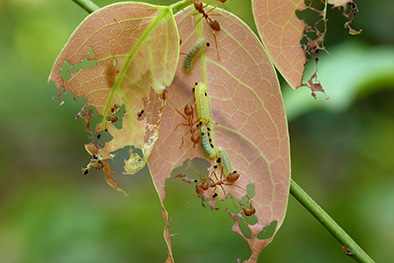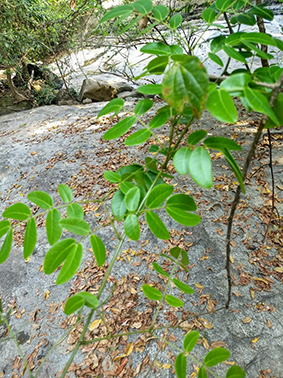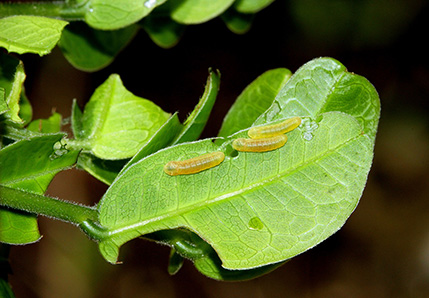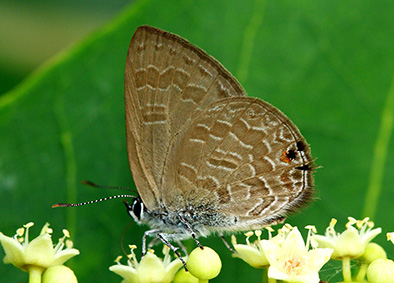The genus Anthene Doubleday, 1847 is a group of small blue butterflies of Lycaenidae family. They are commonly called ‘Ciliate Blues’ or ‘Hairtails’. This is largely an Afrotropical genus with a weak extension to the Oriental region. Out of 130 plus species of this genus only 9 species (Tite 1966) are from Indo Malayan, Australasian and Palearctic (Himalayan region) realms. In India, two Ciliate Blue species are known viz., Anthene emolus Godart, 1824 (Common Ciliate Blue) and Anthene lycaenina Felder, 1868 (Pointed Ciliate Blue) (Varshney & Smetacek 2015). Both the species (A. emolus emolus and A. lycaenina lycaenina) are having a quite good distribution in Kerala, but their occurrences are not uniform. A. lycaenina is often observed from post monsoon months up to April, and seen in good numbers near streams of forests and well wooded areas, where its larval host plants like Acacia sp. are seen in abundance. Their larvae mostly feed on the flower buds. Whereas in A. emolus emolus (Common Ciliate Blue), its larvae feeds on the tender leaves of the host plants, and the presence of weaver ants (Oecophylla smaragdina) is  inevitable (Chandrasekharan, personal observation) for the survival of their larvae in the wild. This butterfly is not a common species in the state, but may be encountered in one or two at any time in the year depending mainly up on two factors i.e., the presence of weaver ants and the tender leaves on its host plants. This species is seen even in cities of Kerala, in congenial circumstances.
inevitable (Chandrasekharan, personal observation) for the survival of their larvae in the wild. This butterfly is not a common species in the state, but may be encountered in one or two at any time in the year depending mainly up on two factors i.e., the presence of weaver ants and the tender leaves on its host plants. This species is seen even in cities of Kerala, in congenial circumstances.
As per the updated list of larval food plants of the butterflies of the Western Ghats by Nitin et al. (2018), the plants listed for Anthene emolus emolus are Mangifera indica (Anacardiaceae), Combretum latifolium (Combretaceae), Terminalia paniculata (Combretaceae), Cassia fistula (Leguminosae), Saraca asoca (Leguminosae), Heynea trijuga (Meliaceae), Litchi chinensis (Sapindaceae).
In the present communication, I am herewith presenting three new larval host plants of Anthene emolus emolus (Common Ciliate Blue) from Kozhikode district, Kerala, India. The details are as given below.
1. Early stages of A. emolus emolus have been recorded successfully by me in 2015, from Kakkavayal, Kozhikode District, Kerala The larval host plant has been identified as Entada rheedii, (African Dream Herb, Kakavalli in  Malayalam)(Leguminosae), a large woody climber. Eggs are laid on the tender shoots singly or in small groups. The weaver ants (Oecophylla smaragdina) present on the plant attend to the larvae and pupae.
Malayalam)(Leguminosae), a large woody climber. Eggs are laid on the tender shoots singly or in small groups. The weaver ants (Oecophylla smaragdina) present on the plant attend to the larvae and pupae.
2. In 2017 and 2018, I have observed egg laying of this butterfly on Terminalia catappa (Tropical Almond tree, Badam Maram in Malayalam)(Combretaceae), having weaver ant nests on it, at Koyilandy, Kozhikode, but was unable to collect the larvae or take images, since the leaves were at out of reach height.
3. The third new hostplant recorded is Connarus wightii (Connaraceae), and about twenty plus larvae in different instars were observed on the tender leaves of a small Connaraus wightii plant at Koyilandy, Kozhikode district, Kerala on 19th April 2020.There was also a nest of Oecophylla smaragdina ants on the matured leaves. Some larvae in advanced instars were seen near the ant nest. All larvae were vigorously being attended by ants.
With this addition of three new larval food plants for the Common Ciliate Blue, Anthene emolus emolus, from Western Ghats, the updated list of larval foodplants for the species is given below.
1. Mangifera indica (Anacardiaceae) (Nitin et al. 2018)
2. Combretum latifolium (Combretaceae) (Nitin et al. 2018)
3. Terminalia paniculata (Combretaceae) (Nitin et al. 2018)
4. Cassia fistula (Leguminosae) (Nitin et al. 2018)
5. Saraca asoca (Leguminosae) (Nitin et al. 2018)
6. Heynea trijuga (Meliaceae) (Nitin et al. 2018)
7. Litchi chinensis (Sapindaceae) (Nitin et al. 2018)
8. Entada rheedii (Leguminosae), Newly added.
9. Terminalia catappa ( Combretaceae), Newly added.
10. Connarus wightii (Connaraceae), Newly added.
 In my observation, while a variety of flora pertaining to different families, is selected by Anthene emolus emolus as its larval host plants, one main criteria of selection is the presence of weaver ants. As in the cases of Arhopala amantes (Large Oakblue), Arhopala centaurus (Centaur Oakblue), and Zesius chrysomallus (Red spot) , the larvae of Anthene emolus emolus are also vigorously attended by weaver ants (Oecophylla smaragdina) and this association is needed for their protection, moulting and pupation in the wild, even though some larvae are killed by major ants (presumably by accident).
In my observation, while a variety of flora pertaining to different families, is selected by Anthene emolus emolus as its larval host plants, one main criteria of selection is the presence of weaver ants. As in the cases of Arhopala amantes (Large Oakblue), Arhopala centaurus (Centaur Oakblue), and Zesius chrysomallus (Red spot) , the larvae of Anthene emolus emolus are also vigorously attended by weaver ants (Oecophylla smaragdina) and this association is needed for their protection, moulting and pupation in the wild, even though some larvae are killed by major ants (presumably by accident).
Acknowledgements
I sincerely thank Suresh Kutty for identifying the plant species. I am also grateful to V. C. Balakrishnan, Satheesh Pullat, Vinayaraj V. R., Balakrishnan Valappil and Jafer Palot for their help and support.
References
1. Nitin, R., V. C. Balakrishnan, P. V. Churi, S. Kalesh, S. Prakash, & K. Kunte, 2018. Larval host plants of the butterflies of the Western Ghats, India. Journal of Threatened Taxa 10(4): 11495-11550. DOI: http://doi.org/10.11609/jot.3104.10.4.11495-11550
2. Tite, G. E., 1966. A revision of the genus Anthene from the Oriental region. Bulletin of the British Museum (Natural History) 18: 253-275.
3. Varshney, R. K., & Smetacek. P. (eds), 2015. A Synoptic Catalogue of the Butterflies of India. Pp. i-ii, 1-261, 8 pl, Butterfly Research Center, Bhimtal and Indinov Publishing. New Delhi.
Additional references not cited in the text
4. Wynter-Blyth, M. A., 1957. Butterflies of the Indian Region. Bombay Natural History Society, Mumbai.
5. Cantlie, K., 1963. The Lycaenidae portion (except Arhopala group) of Brigadier Evans’ The identification of Indian Butterflies, Pp. i-vi, 1-156, Bombay Natural History Society, Bombay.
6. Chandrasekharan,V. K., & S. Sondhi., 2020. Anthene emolus (Godart,(1824)) – Common Ciliate Blue. Kunte.K., K. S. Sondhi and P. Roy(Chief Editors). Butterflies of India, v.2.82. Indian Foundation for Butterflies http://www.ifoundbutterflies.org/sp/548/Antheneemolus.
7. Kehimkar, I., 2016. Butterflies of India. , Bombay Natural History Society, Mumbai
8. Robinson, G. S., P. R. Ackery, I. I. Kitching, G. W. Beccaloni & L. M. Hernandez, 2010. HOSTS – A Database of the World’s Lepidopteran Hostplants. Natural History Museum, London. URL: http://www.nhm.ac.uk/hosts.
